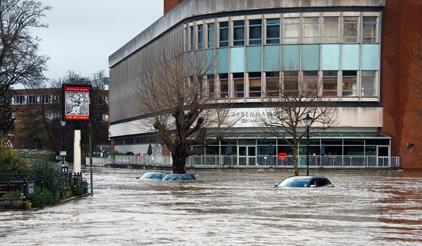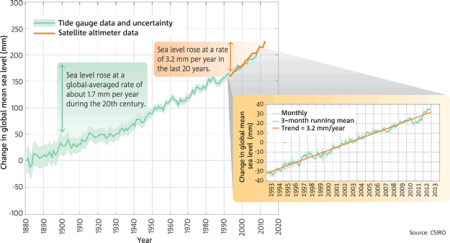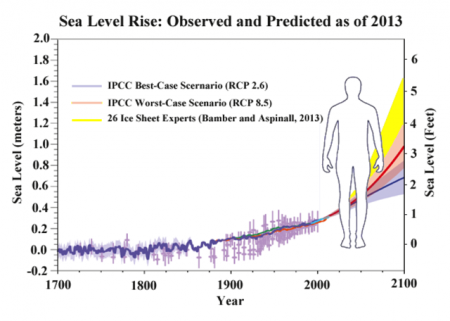April 21, 2015 – I wonder how deeply this headline will get buried but it is one to which most of humanity need pay attention. Since 1993 ocean sea levels have been rising by 3.1 millimeters per year. Over 11 years that amounts to 3.41 centimeters (1.34 inches). That means, should the trend continue, the places where most of us live, coastal cities and floodplains are threatened.
Measuring sea levels has always been difficult because it varies across the planet. But since 1991 our satellite networks have for the first time given us a global view of our oceans. Altimetry readings can be calculated continuously by these satellites. That’s a departure from the past when we had an imperfect view of ocean sea levels using tidal gauge readings from coastal observation stations and harbors. Now we can measure sea level height from mid-ocean to shorelines.
Using our old way of measuring sea level scientists estimate that throughout much of the 20th century the average sea level rise was between 1 and 2 millimeters annually. In some cases where land was subsiding tidal gauges showed a sea level rise when in fact it was coastal sinking that was the culprit.
But now we have the means to see our entire planetary ocean through a network of satellites and any way you look at it the new findings demonstrate evidence of acceleration. Why is that?
Two reasons:
- Thermal expansion – Many of those same satellites that give us accurate measures of sea level also provide us with measures of ocean density. The ocean is a heat sink and as atmospheric warming has occurred some of that heat has transferred into the sea. Warm water expands and that causes the water mass to change. In the Mediterranean alone the warming has caused a 2.1 millimeters per year rise since 1993.
- Melting continental and sea ice – Satellites have also been studying Greenland, Antarctica and the ice of both the Southern and Arctic Oceans. The evidence describes a changing pattern within the land-based ice sheets as well as a thinning of sea ice. We are starting to see the breakup of ice shelves on polar coastlines. The shelves hold back the land-based ice sheets and as the former disintegrate the latter accelerate in their movement toward to the ocean. Scientists speculate on what level of contribution this land ice rush to the sea will do to ocean sea levels, but it will certainly be more than a few millimeters per year.
In a recent report by E3G, a non-profit European organization focused on sustainable development, entitled “Underfunded, Unprepared, Underwater? Cities at Risk,“ the authors describe the foreseeable risks to Europe’s many coastal cities. The evidence of these rising seas is already on display state the authors. For example, Copenhagen, the coastal capital of Denmark, suffered a 1 in 100 year flood in 2010 and 1 in 1,000 year flood in 2011. In fact like Copenhagen much of the North and Baltic Sea coastlines are under threat. Should the Intergovernmental Panel on Climate Change (IPCC) predictions of global sea level increases between 30 and 70 centimeters (11.8 to 27.6 inches) happen by the end of the 21st century, the coastal cities of this European region will be underwater. What is more alarming is the IPCC prediction didn’t include sea level rise from the collapse of land-based ice sheets from Greenland and Antarctica.
Today London, Rotterdam and Venice are building or have completed flood barrier projects to protect them from rising sea levels. But these barriers, based on current evidence, are only good for another three decades before they will have to be raised further. What about Amsterdam, Brussels, Marseille, Naples, and many others?
In a previous posting at this site I described the need for humanity to invest $89 trillion US to deal with climate change. One of my readers asked “who would pay?” For the citizens of cities under threat that is not the relevant question. They are asking “how can I save my city and what will it take?” It is pretty clear that we all can be making a contribution. In doing the mental exercise to breakdown that $89 trillion number I came up with a global daily cost over the next fifteen years of $6 billion. With 7.2 billion of us on the planet that works out to approximately 83 cents per day, all things being equal, from each of us. Of course 83 cents in the Developing World may be too much for individuals to handle. So those of us in the Developed World can maybe contribute $2 or 3 per day. Who among us, now knowing what’s at stake, wouldn’t consider that a good investment?

















[…] Since 1993 the average rise is 3.2 millimeters, over an inch per decade. Most of that is thermal expansion and not from melting polar ice. […]